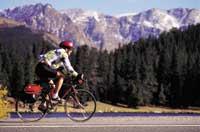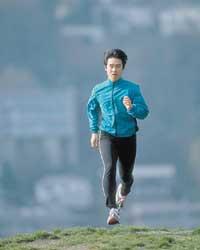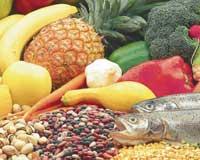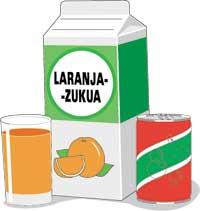Principles of food in sports
2002/07/01 Lorenzo, Arantza | Uranga, Ane Miren Iturria: Elhuyar aldizkaria
The most important energy base for sports is glucose. In addition to strengthening the body's muscles, it has benefits such as reducing blood fat levels and protecting them from heart disease, reducing type II diabetes problems (by facilitating insulin work), etc. On the other hand, the balance that is achieved with the body itself is very suitable, especially in developed societies where work makes less and less movement.
But before starting to play sports, you have to adapt the diet and offer the body the necessary ingredients to face this activity. In addition, in the coming hours we must also adapt the food and drink, both during the activity and at the end of the same. The adaptation of nutritional needs allows to obtain a suitable performance and, at the same time, avoid the exhaustion of the body. To avoid the onset of this fatigue it is essential to maintain blood glucose levels, and for this they have much to see the body glycogen deposits (liver and muscle storage). In addition, workouts also increase muscle glycogen levels.

In this sense, in the world of sport there is a well-known diet, called ‘Tapering’, which serves to achieve a high level of glycogen. It is recommended to make this diet the week before the start of competition or important physical effort. During the first four days, the athlete must consume little carbohydrates, which means a maximum of 45-50% of the daily energy. In this way, the glycogen deposits of the muscles are emptied and prepared for filling. During the following three days a diet rich in carbohydrates is recommended. In those days, between 60% and 70% of the daily energy must be composed of carbohydrates, that is, we consume between 400 and 600 g of carbohydrates a day, mainly of legumes, cereals, vegetables and fruits.
Once the sport is practiced, to prepare it for another session it is essential that glycogen deposits be filled as soon as possible, and in this process three factors influence:
- Time elapsed between exercise and ingestion of new carbohydrates.
- Type of carbohydrates consumed.
- Amount of carbohydrates consumed.
They say it is very good to drink a carbohydrate drink before fifteen minutes after finishing the sport and two hours later make a juicy meal, composed of rice, pasta, potato and food of this type.
Professional athletes should take special care of the amount of protein, since we must not forget that the muscles are composed of proteins, so athletes, for their activity, need more: if for every kg of average daily weight we need 0.8 g of protein, athletes need 1,2-1.4 g of protein.
As is well known, the body uses oxygen to obtain energy and, when a lot of energy is needed in sports, numerous waste is generated as free radicals. For its elimination the body needs antioxidants, being vitamins A, E and C the most effective. Therefore, when playing sports we need more than normal these vitamins to eliminate free radicals that are enemies of the body and thus avoid serious problems such as aging body tissues.
Isotonic drinks
In sports, sweat water loss is usually high and, to avoid dehydration problems, the athlete must drink before feeling thirsty, especially in long-lasting sports. But often it is not enough to drink water. Therefore, it is recommended to practice sports and ingestion of isotonic drinks as soon as possible, in order to meet the nutritional needs of the body as soon as possible and thus minimize its consequences.
All drinks that should be taken during sports have as main component water, but also contain other ingredients to improve their performance. Drinks aimed especially at athletes contain glucose, fructose, sucrose and monosaccharides and disaccharides maltose, carbohydrates that are rapidly absorbed into the small intestine. Being starchy would take much longer to appropriate the body, and therefore would be left without meeting the body's energy needs.

However, it seems that the presence of simple carbohydrates in these drinks is not only due to their energy source, since the association of carbohydrates with salts facilitates the absorption of water by the small intestine, especially when these are glucose and galactose, so all drinks prepared for athletes, along with glucose, contain about milligrams of sodium. However, it must be said that the amount of carbohydrates in these drinks is usually measured. The average amount of carbohydrates is 6%, above which water losses and intestinal disorders occur.
A known drink that contains more than this amount of carbohydrates is Coca-cola, so this drink is not recommended for athletes. Water, on the other hand, does not contain carbohydrates or sodium, so, although it is very suitable for the body, it is not specially prepared to meet the needs of athletes.
These drinks contain, in addition to sodium, potassium, chlorine, phosphorus, calcium and magnesium. All these mineral salts are essential for muscle contractions. As for vitamins, some do not contain isotonic drinks, others contain antioxidant vitamins C and E. Vitamin C responds faster to the body's water needs and helps hydrate.
The best known isotonic drinks are Aquarius, Isostar, Gatorade, etc. are. The differences between them are small, but they exist, and the most appropriate are those that have between 6-8% carbohydrates when choosing; as for other ingredients, the more content in mineral salts and vitamins the better.
After sports, no coffee or alcoholic beverages are recommended: coffee is diuretic and increases the lack of water. Drinks with caffeine (Coca-cola, Pepsi-cola, etc. ). ), they are not recommended because they are stimulants and the body, after doing sports, is relaxed, so this type of drinks do not benefit the body. Alcoholic beverages offer a lot of energy, 7 kilocalories per gram of alcohol, but to do so they ‘steal’ a lot of vitamin from the body.

Gai honi buruzko eduki gehiago
Elhuyarrek garatutako teknologia





